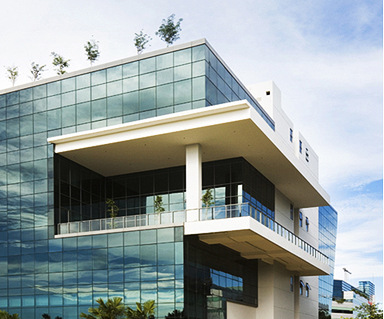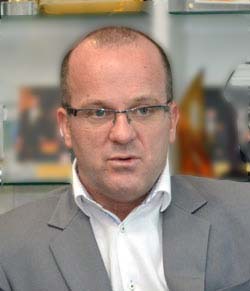 Soilbuild's Eightrium: an eight-storey east wing and a six-storey west wing interlinked by a five-storey atrium, located within Changi Business Park.DBS Vickers has a 'buy' call on Soilbuild Business Space REIT which, at current prices, offers dividend yields of 7.9-8.5%, one of the highest among industrial S-REITs in the research house's coverage.
Soilbuild's Eightrium: an eight-storey east wing and a six-storey west wing interlinked by a five-storey atrium, located within Changi Business Park.DBS Vickers has a 'buy' call on Soilbuild Business Space REIT which, at current prices, offers dividend yields of 7.9-8.5%, one of the highest among industrial S-REITs in the research house's coverage.
The REIT's 4Q13 dividend per unit of 1.5 cts beat its own prospectus forecast by 3.4%.
In total, the DPU since listing (Aug 2013) have totalled 2.27 cents versus the prospectus forecast of 2.199 cents.
DBS Vickers expects the REITs growth momentum to continue into 2014, maintaining its target price of 87 cents.
Incorporating the better-than-expected results into its forecasts, OCBC Investment Research raised its fair value from 82 cents to 85 cents while maintaining its 'buy' call.
AmFraser Research, noting Soilbuild REIT’s annualized yield of 7.8%, said it is compelling given the quality of its assets, longest weighted average land lease and diversified lease expiry profile.
AmFraser's target price is 87 cents.
The REIT's management met up with analysts and fund managers recently in 2 different sessions.
Here are the questions and answers (as provided by CEO Shane Hagan, CFO Kelvin Chow, COO Roy Teo and Head of IR and investment Russell Ng).
Q: What are some of your acquisition plans for this year and in what segments?
 CEO Shane Hagan. NextInsight file photoA: The likelihood is that acquisitions this year would be from third parties. The most imminent one would be the one at Bukit Batok. The construction is scheduled to complete towards the end of this year and given some time for stabilisation, the acquisition would most likely take place in 2015. The next segment we are looking at would most likely be redevelopment and asset enhancement opportunities within our ROFR (right of first refusal) pipeline. That will be in consideration for the longer term.
CEO Shane Hagan. NextInsight file photoA: The likelihood is that acquisitions this year would be from third parties. The most imminent one would be the one at Bukit Batok. The construction is scheduled to complete towards the end of this year and given some time for stabilisation, the acquisition would most likely take place in 2015. The next segment we are looking at would most likely be redevelopment and asset enhancement opportunities within our ROFR (right of first refusal) pipeline. That will be in consideration for the longer term.
Q: Will you be doing any acquisition in the business park space?
A: It is quite unlikely that we will be doing any acquisition in the business park space due to the limited opportunities. However, we will look at it if an opportunity comes along but we will more likely be looking at the industrial space.
Q: Can you share a little more on the rental rates?
A: If you refer to the median rent for business park, we are closing S$4 psf for CBP (Changi Business Park). This is challenging for our portfolio as compared to Tuas Connection and West Park where we see continued tenant demand. The tenant demand and enquiry at CBP has not been as strong as compared to previously. There are also some underlying vacancies at the CBP. This is one area where we will have continued focus on for this year.
Q: How are you handling some of the expiring leases?
A: Of the 17% leases or half a million square feet expiring, 47% have already been pre-committed.
Q: With reference to some of the expiring rents, are you still expecting to have a positive reversion?
A: Yes, slightly except for one at CBP.
Q: In terms of your growth strategy, how do you see yourself benefiting from the URA Master Plan?
A: The URA Master Plan usually brings about a revitalisation of the selected areas. We expect some of our current properties such as West Park to benefit from it. It is located at Tanjong Kling, which used to be a run down area. However, over the last two years, the URA, LTA and JTC have developed road infrastructure and launched strata sale development. Strata sale developments are usually launched in areas where the necessary infrastructures are in place in order to suit multi-occupancy. West Park is one of the beneficiaries in the Tanjong Kling area, which brings about higher value for us and our tenants.
If you look at the URA Master Plan, a large part of it is focused on the Woodlands area, which is a very old estate of more than 20 years. They have recently launched commercial land for tender, which is only closing in March 2014. This will bring about a new spurt of growth in the industry. While we are currently not present in these areas, we are looking at acquiring some of the assets, which may be undervalued for the time being but in time to come, the valuations will ensue when the relevant infrastructures are in place.
There are only so many pockets of industrial space in Singapore and the URA Master Plan reinforces our areas of concentration.
Q: With regard to acquisitions, can you give us a sense of the potential returns? Also, will it be plain vanilla type of acquisitions or will it involve some forms of value enhancement?
 CFO Kelvin Chow. NextInsight file photoA: We have looked at about 40 different opportunities and evaluated on various aspects such as price, competition, etc. We have identified a range of opportunities such as outright property acquisition, asset enhancement and property development. For some, we have to bear in mind that it involves master leases.
CFO Kelvin Chow. NextInsight file photoA: We have looked at about 40 different opportunities and evaluated on various aspects such as price, competition, etc. We have identified a range of opportunities such as outright property acquisition, asset enhancement and property development. For some, we have to bear in mind that it involves master leases.
This also extends to some opportunities such as sale and leaseback where we will do the construction. We identify this as a niche for us because there is a lot of competition out there in the market. There was one particular transaction where we stood out among the other REITS because we had the construction capabilities and we can take ownership. We were competing with private developers as well. With the continued change in the regulatory rules, we may not see the private developers as competitive as before. This is therefore to our advantage.
Currently, we are considering acquisitions which involve sale and leaseback or transactions that may involve asset enhancement. This is an area where we can leverage on our niche.
Q: How are you managing your swap rates as you have some expiring in the near term? Do you remain well hedged?
A: As we acquire properties, we will push it to a longer term so that our average debt maturity will increase. We put a 1 year swap as there was much uncertainty about the tapering of the stimulus. We do not actually see much volatility for the 3-month rate over the last 3-5 years.
Q: How far more can you push in your acquisition before you reach your limit?
 COO Roy Teo. NextInsight file photoA: This is on a case by case basis. We have the capacity to increase up to S$100 million. In our credit rating issued by S&P, we had indicated to them that we will be limiting our gearing ratio between 35-40%. This is relatively binary as 35-40% would be BBB- while anything in excess of 40% would be BB+. Our comfort level would coincide with our more conservative approach of maintaining a 35-40% gearing ratio.
COO Roy Teo. NextInsight file photoA: This is on a case by case basis. We have the capacity to increase up to S$100 million. In our credit rating issued by S&P, we had indicated to them that we will be limiting our gearing ratio between 35-40%. This is relatively binary as 35-40% would be BBB- while anything in excess of 40% would be BB+. Our comfort level would coincide with our more conservative approach of maintaining a 35-40% gearing ratio.
Q: What are your views on why the share price for Soilbuild REIT has not improved?
A: Ever since the first time we started talking to investors, the underlying concerns have not changed. It is not about the fundamentals of our company but rather on the macro view of the economy. In fact, we would like to hear from you analysts about the macro issues such as the tapering, interest rates, etc. Has this been factored in the share price or do we expect further downside?
If you look at the CAP rates in Singapore, historical trends reveal that it does not vary significantly even as interest rates change. As long as the portfolio is well-staggered, then the impact should be immaterial.
Q: We heard from some large investors that there are some concerns about the Singapore dollar depreciating. Do you expect some cause for concern over currency issues?
A: For some investors, they are definitely concerned about the Singapore dollar as some find it to be overvalued at current levels. It was a completely different story some 12 months ago.
|
Q&A session 2. A: The tenants are likely not to renew so we are opening the lease to the market. Of the 17% due for renewal, equivalent to about half a million square feet, 47% has been pre-committed so the balance are negotiable. West Park contributes to about 300,000 square feet. Q: Who are those who had pre-committed? Will it also be at market rates? A: The 47% pre-committed lease is by Soilbuild Storage. The rental rates are pre-determined, which is about S$1.55 – S$1.60, which is actually higher than the existing tenants. Q: Is there any seasonality in your business, such as quarter-to-quarter variation? A: No, as we are not like the other retail REITs who might experience this. Q: So at 1.51 cents DPU for a full quarter, is it safe to assume that as a base to be multiplied by four going forward? A: In accordance to the IPO prospectus, it is about that figure. Q: That is about an adjusted 7.8% yield and adjusted for debt, which gives an asset carrier of about 6%. In your pipeline for acquisitions, is 6% possible and if so, guide us on why it is possible. A: If we look at potential acquisitions out there for industrial properties, it is not as easy as it was. It was a completely different market from a few years ago but there are opportunities out there. We can expect NPI (net property income) yield in excess of 7% which will serve as an average figure for us to work on. Q: What is the expected size of acquisition? A: It really depends on what is available. Recently, we saw something that might be suitable where we might close. Due to the limitations in development, this is an area where as we grow, we will have a competitive edge as we have a construction business within our group. This opens up to a range of opportunities as it allows us to advance most among industrial REITs. The private developers could potentially be competitive but given the recent introduction to regulatory changes, this will limit their competitiveness moving forward. We therefore expect to benefit most from this. Q: Could you elaborate on how the change in rules have hampered the private developers and how it benefits Soilbuild REIT? A: The JTC announced new measures on 15 November 2013. They are trying to tackle the industrial properties. For the sale and leaseback space, for land titles longer than 30 years, JTC requires a leaseback of 10 years. For land leases shorter than 30 years, JTC requires a leaseback of a minimum of five years. For development, there is a no sale period for developers. This effectively targets the private developers who try to flip their properties for a quick gain. They are subjected to a minimum holding period, which is equivalent to the lease holding period for the tenants with an additional one to two years. The overall changes are actually good for REITs because the tenant base would most likely be stronger and better. The potential for private developers to come in and do acquisitions that they could flip easily and dispose off would most likely disappear in due course. It is therefore positive for REITs overall. Q: What does having your parent Group as a backup help you relative to some other REITs? A: The parent is giving us support in the form of construction, such as design. The short turnaround time for us to do the proposal to the end-user is our competitive advantage. In the event that a project size exceeds our development cap, then we have the flexibility to do a certain joint venture. They could double up to be our JV partner or provide consultancy on construction projects. Q: How do you expect to collaborate with your parent company when the occasion arises? A: In the Singapore REIT market, there has been the use of LLP cooperation. This structure could potentially be used for purposes such as application of JTC approvals, tax issues and tax transparency. This structure is one of the most efficient structures to use. Q: Going back to the change in JTC rules, could you elaborate further on how it helps the REITs vs the non-REITs? Does it mean that supply is constrained or buyers are restrained? A: We had a situation whereby we were trying to match a deal put forth by a private developer who focused on NPI yield and construction costs. That developer could only be doing that deal for the purpose of reselling a short period after construction. That was the only way that the deal would make financial sense for them. Now, with the change of rules, whereby they are caught in a situation, depending on the length of the land lease, they would have to hold for a considerable period. Private developers would thereby not be as competitive when it comes to cutting edges on particular deals. It puts all companies on a level-playing field. Adding on, most of the Built-To-Suits typically get allocated to us if they take on a 10-year lease. The developer essentially has to sit on the land for at least 10 years, henceforth his capital is tied down. Q: What are your acquisition plans like? A: Let me start with the four assets in the pipeline. The most probable one would be the one at Bukit Batok. The construction is scheduled to complete towards the end of this year and given some time for stabilisation, the acquisition would most likely take place in 2015. The other three assets would most likely be redevelopment opportunities which would be middle-long term. Q: Can you remind us about how the Soilbuild lease is structured? A: The master lease has a 5-year master lease plan as required by JTC. The rental rate starts from about S$4.75/psf growing by 3% per annum on the 1st of April. If you compare that to the market rental rate of about S$5 – S5.50, which has not changed much from the queries that we are receiving. On a 5-year horizon at the increment of 3% per annum, we are looking at about S$5.42 which coincides with today’s market rental rate. We see good tenant enquiry at the One-North area despite the increase in competition from other REITs. Q: What is the occupancy rate like at One-North area? A: It stands at 97% now. There is one tranche of space available but we have enquiries on it at the moment. Q: What happens at the end of the master lease? A: We will be facing the tenants directly. Q: Why is the market punishing you in terms of the share price? Can you share some of the reasons? A: Over the last year, the typical REIT investors were not in the market. We had gone IPO in the midst of a difficult market. The traditional appetite for the real estate and REIT investors is certainly different now as compared to as at the start of last year. I do not think you have seen a lot of successful IPOs in this type of market. I believe the underlying issue is more of macro factors rather than micro. We are well-positioned when it comes to the micro aspects but it is the macro scene where we face uncertainties in the market which are key drivers in terms of share price performance today. Q: Could one of the reasons be the implementation of a master lease structure? A: I do not agree with that. From my meetings with the various investors, I have generally encountered positive feedback on a master lease structure as it underpins the returns. I think the market is generally okay with the master lease structure and at the end of the day, we had no choice as it was a trophy asset that was part of the IPO portfolio. While JTC made us have a 5-year master lease, our view is that investors will have the certainty of having the master lease for 5 years and benefit from the underlying fundamentals of real estate after the 5 years. There is no financial engineering in the numbers and we are definitely confident of delivering them. Q: So, you think that it is mainly macro issues and no micro? A: I think for the market that we are trading in, it is about the situation. For some REITs, they have a management fee structure. We are just looking to establish a solid track record, make some acquisitions and ensure that the underlying portfolio is performing well and ultimately to exceed the IPO price. That would be the celebration for us. Q: Do you expect a challenging time in the business park space? A: We do not see the same enquiries as compared in the past and we have seen some new opportunities coming up which were never present in the past. If you track the other REITs, at CBP, there are some new properties which have just been completed and there were some which just underwent asset enhancements. There are also potential assets in the market looking for tenants. Q: How about the Built-To-Suit market? A: The Built-To-Suit at CBP were mostly completed in 2009/2010. Right now, a few REITs are doing asset enhancements which will free up more space. One of the benefits that we possess at the CBP area, apart from the support from the construction group, is that we have no JTC restrictions on leasing unlike some of the other properties which require sale and leaseback. Most of our tenants are recurring tenants. Q: Given the low liquidity of your counter and market valuations and being smaller than some of the bigger REITs in the market, what is the organic growth and assessment of total returns growth over the next few years? You also mentioned about upcoming acquisitions -- how does this appeal to investors interested in total returns growth? If your acquisitions are only going to take place further down the road, then it might not seem such an attractive play for yield-return investors at this point in time. A: At 29.3% gearing, we know that we can acquire up to S$100 million worth of new properties. Assuming that the average yield is about 7% and we can finance it at about 3.75%, being a conservative figure, there is certainly good accreditation to it that will enhance the total return story. For us, we have to show the track record and pursue the acquisition gradually. Q: Are you looking to do one big acquisition for the year or are you looking to do more than one? If so, would you consider doing some equity raising from the market? A: It really depends and we evaluate the opportunities case by case. We see several opportunities so we will be discussing with our bankers on the size of our facility. It is too premature to discuss about that at this point in time. Q: Is there any feedback from your current tenants? A: We see it coming from the low-end manufacturers as their complaints range from rental to workers’ levies. We also see quite a fair bit of outright sale of properties from manufacturers, which was not common previously. These companies no longer have a presence in Singapore but such is the reality in the market. Some of the new entrants include chemical, marine offshore oil and gas companies increasing their presence in Singapore, from assembly, manufacturing to servicing. |
Recent story: SOILBUILD REIT: Niche player in Singapore business parks







